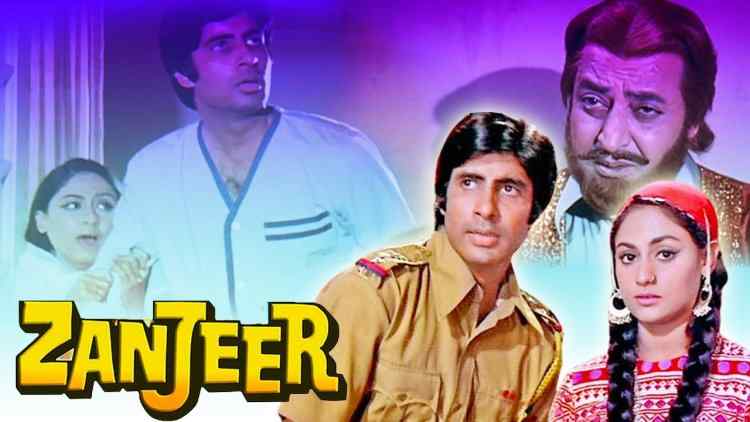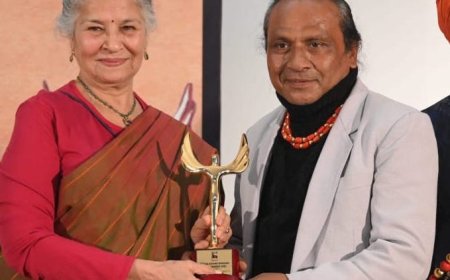FIFTY YEARS OF ZANZEER BACHCHAN AS “THE OTHER”

Dr. Shoma A. Chatterji writes on the fifty years of the blockbuster Hindi film, Zanzeer.
The first characters in Hindi cinema that do have a clearly defined goal to be achieved by any means are those played by Amitabh Bachchan in the 1970s. Bachchan’s ‘angry young man’ was a successful mixture of gangster-film, social critique and personal charisma. Most of the characters Bachchan played were proletarians: coolies, mine workers, smugglers and so on. Though public morals forbade that the Bachchan character wins in the end, he was the perfect active agent of the plot. His actions were propelling the narration forward; he was the driving force.[1]
Tieber adds: “The angry young man persona is always connected to characters, which represent the diverse minorities and marginalized groups in Indian society. These characters – Muslims, Christians, widows, prostitutes, etc – function as "donors" in Propp's definition of the term.[2] Vijay's fight against the system is thus also representing a broader struggle against a corrupt system. The ideological subtext of these character constellations may also have something to do with the background of the screenwriters: Salim Khan and Javed Akthar are both Muslims, working in an industry that is dominated by Hindus, but in which Muslim elements as well as Muslim workers (directors, actors, screenwriters, lyricists, composers etc) play a more important role than outside of Bollywood.”[3]
This very marginalization of Vijay and all the other “angry” and “not so angry” celluloid avatars of the Bachchan persona mark him out both as “the other” and as “the outsider” and these two terms in these films at least, overlap considerably where few can mark out where the one ends and the other begins because these “beginnings’ and “ends” simply do not exist.
One of the most outstanding features of Amitabh Bachchan's films between the 1970s and the mid-1980s is that he stood out as not only the marginal hero but also as the secular hero, which we will learn in some of the following chapters. This adds to his screen image as “The Other” who is basically, a lonely human being rendered lonely mainly through circumstances beyond his control and also, to some extent, by events defining his destiny.
Prakash Mehra with sparkling one-liners, chartbusters, and high-end melodrama, knew how to give the emotional Indian audience the price of its movie ticket. His partnership with Amitabh Bachchan, which yielded six successive hits between 1973 and 1984, earned him an entry in the ‘Golden Directors’ list which included his peer and great rival, Manmohan Desai.
Zanzeer with Amitabh Bachchan started a long-term and successful collaboration that spanned seven more films, of which six were blockbuster hits: Hera Pheri, Khoon Pasina, Muqaddar Ka Sikandar, Lawaaris, Namak Halaal and Sharaabi. Their final collaboration was Jaadugar which was a flop and ended their successful streak. Zanjeer was the film credited with launching the career of Bachchan as a lead actor and their final film together Jaadugar was released towards the declining period of Bachchan's career.
Bachchan, thanks to the complete faith his writers Salim and Javed placed in his tremendous talent, his physical stature, his voice and his personality, took courage in their hands to create the very different script of “the other” and persuaded with great difficulty, to choose Bachchan to portray the very angry young man in Zanjeer. The character was earlier summarily rejected by top actors of the time such as Dilip Kumar, Dev Anand, Dharmendra and Raaj Kumar who, perhaps shied away from playing such an off-beat young man for who, romance was marginalized to his duty and obligations of a police officer he was determined to stick to with the honesty it demanded. Then, within this commitment to wipe out criminal elements, he chances upon Teja, the cold and calculating villain of the piece (Ajit), then known as a very successful industrialist in the city.
While investigating the crimes this man involved him, such as illegal trafficking in liquor, Vijay, the policeman, recognizes in this man the person who killed his parents in cold blood when he was a little boy and he had been witness to this from a hidden place which saved his life. The principle of honesty is converted to the ideal of revenge and his anger comes out in full blast, marginalizing everything else in his life, including the imminent danger to his life by Teja and his cronies and the fear his lover Mala (Jaya Bachchan) expresses about the danger to his life.
He discovers an honest “gang leader” in his Pathan friend Sher Khan (Pran) whose first introduction introduces the anger and the angst of Vijay who has been transferred from one police station to another 11 times in five years precisely for his bursts of anger and violence when he encounters the unfairness of the system and the flourishing of crime and criminals disguised as influential businessmen in the city.
As a child, Vijay witnesses the murder of his parents by their unscrupulous employer, worried that they will spill the beans on his "spurious injections" business. As luck would have it, Vijay was hidden in a wardrobe at the time and all he sees of the killer is his golden chain, with a cute little plastic horse dangling from it. Twenty years later, Vijay has morphed into a police officer, always in trouble with his superiors because of his tendency to take crime as a personal affront and use any means available to punish its perpetrators.
He is a very serious and intense young man, haunted by nightmares of his parent’s murder. When the little Vijay watches his parents being killed from behind his hiding spot, he cannot catch any glimpse of the killer except a bracelet worn by the killer which has a horse hanging as a medal from the bracelet. Different film scholars have offered varied interpretations of this dream along with that little white horse dangling from the hand of the killer Teja.
What do these objects signify? The bracelet serves as memory in the mind of the grown-up Vijay who identifies the killer from this bracelet and weaves it into the identity of today’s Teja considered an influential “industrialist” in Vijay’s present identity as a police officer. Having recognized him as the man who killed his parents, Vijay finally avenges the tragedy by killing Teja which he attempts but is achieved a bit differently to rescue Vijay from being labelled a killer. In that case, it would wipe out the differences between Teja, the epitome of Evil and Vijay, symbolizing honesty, determination and anger.
The nightmares of the white stallion continue to haunt him through adulthood and disturb him but only as long as the nightmares last. They apparently disappear once Vijay triumphs in avenging the murderous killing of his parents that rendered him an orphan, a loner and an introvert who is nervous even to admit to Mala that he has fallen in love with her. The nightmares shape Vijay into the tough, resilient young man with a strong sense of honour and morality. But it also subtly points out his complete sense of loneliness somewhat lessened when he forms a strange bonding with Sher Khan who was a criminal and a Muslim and much older in age than Vijay – a strange bonding which further underscores Vijay’s identity as “The Other.” Sher Shah is a criminal who owns several lucrative and highly profitable gambling dens who loves to have a lot of fun, eat, sing and dance and wear colourful clothes including a proud moustache. His bonding with Vijay defines one more example where two “Others” can not only be friends but also be solid sources of support for each other.
This period in which Amitabh Bachchan began and consolidated the celluloid image of the “Angry Young Man” however, is erroneous because not in all his film was Bachchan portrayed as the “Angry Young Man.” During the same decade and a bit ahead of it, Bachchan featured in several films in which he was not quite the “Angry Young Man” because that was the label and the cinematic identity that was slapped on him by the media to begin with and then with the mass audience and his fans that were growing in numbers with every passing day.
***
[1] Tieber, Claus: Writing the Angry Young Man: Salim-Javed's screenplays for Amitabh Bachchan, 7 th Annual Conference Screenwriting Research Network, Filmuniversität Konrad Wolf Babelsberg, Potsdam 17.-19.10.2014
[2] Propp, Vladimir: Morphology of the Folk Tale. Austin: University of Texas Press 1968
[3] Ibid, Tieber
What's Your Reaction?

































































